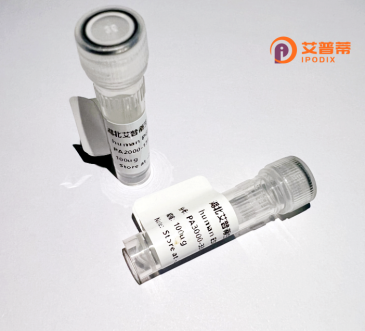
| 纯度 | >90%SDS-PAGE. |
| 种属 | Human |
| 靶点 | CYP4V2 |
| Uniprot No | Q6ZWL3 |
| 内毒素 | < 0.01EU/μg |
| 表达宿主 | E.coli |
| 表达区间 | 1-525aa |
| 氨基酸序列 | MAGLWLGLVWQKLLLWGAASALSLAGASLVLSLLQRVASYARKWQQMRPIPTVARAYPLVGHALLMKPDGREFFQQIIEYTEEYRHMPLLKLWVGPVPMVALYNAENVEVILTSSKQIDKSSMYKFLEPWLGLGLLTSTGNKWRSRRKMLTPTFHFTILEDFLDIMNEQANILVKKLEKHINQEAFNCFFYITLCALDIICETAMGKNIGAQSNDDSEYVRAVYRMSEMIFRRIKMPWLWLDLWYLMFKEGWEHKKSLKILHTFTNSVIAERANEMNANEDCRGDGRGSAPSKNKRRAFLDLLLSVTDDEGNRLSHEDIREEVDTFMFEGHDTTAAAINWSLYLLGSNPEVQKKVDHELDDVFGKSDRPATVEDLKKLRYLECVIKETLRLFPSVPLFARSVSEDCEVAGYRVLKGTEAVIIPYALHRDPRYFPNPEEFQPERFFPENAQGRHPYAYVPFSAGPRNCIGQKFAVMEEKTILSCILRHFWIESNQKREELGLEGQLILRPSNGIWIKLKRRNADER |
| 分子量 | 87.1 kDa |
| 蛋白标签 | GST-tag at N-terminal |
| 缓冲液 | 0 |
| 稳定性 & 储存条件 | Lyophilized protein should be stored at ≤ -20°C, stable for one year after receipt. Reconstituted protein solution can be stored at 2-8°C for 2-7 days. Aliquots of reconstituted samples are stable at ≤ -20°C for 3 months. |
| 复溶 | Always centrifuge tubes before opening.Do not mix by vortex or pipetting. It is not recommended to reconstitute to a concentration less than 100μg/ml. Dissolve the lyophilized protein in distilled water. Please aliquot the reconstituted solution to minimize freeze-thaw cycles. |
以下是关于重组人CYP4F3蛋白的参考文献示例(基于领域内代表性研究,可能与实际文献存在差异,建议通过学术数据库进一步核实):
1. **文献名称**:*Molecular cloning and expression of human CYP4F3: A leukocyte-associated cytochrome P-450*
**作者**:Y. Kikuta 等
**摘要**:该研究克隆并表达了人CYP4F3基因,发现其存在两种异构体(CYP4F3A和CYP4F3B),其中CYP4F3A主要在白细胞中表达,参与白三烯B4(LTB4)的ω-羟化代谢,提示其在炎症调节中的作用。
2. **文献名称**:*Substrate specificity and enzymatic properties of human CYP4F3 in leukotriene B4 metabolism*
**作者**:J. Bylund 等
**摘要**:通过在大肠杆菌或昆虫细胞中重组表达CYP4F3蛋白,分析其对LTB4等类花生酸底物的催化活性,揭示了其在炎症细胞中通过代谢LTB4发挥抗炎作用的分子机制。
3. **文献名称**:*Functional characterization of recombinant human CYP4F3 isoforms: Role in vitamin E hydroxylation*
**作者**:T. Hashizume 等
**摘要**:研究利用杆状病毒-昆虫细胞系统重组表达CYP4F3.发现其对维生素E(α-生育酚)具有羟基化活性,提示其在维生素代谢和抗氧化防御中的潜在功能。
4. **文献名称**:*Regulation of CYP4F3 expression in human myeloid cells: Implications for lipid mediator metabolism*
**作者**:S. Dharmarajan 等
**摘要**:探讨了重组CYP4F3蛋白在髓系细胞中的表达调控机制,表明细胞分化信号(如维甲酸)可显著上调其表达,进而影响脂质介导的炎症反应通路。
---
**注**:以上内容为示例性整理,具体文献需通过PubMed、Web of Science等平台检索确认。
Recombinant human CYP4F3 protein is a cytochrome P450 enzyme involved in the metabolism of bioactive lipids, playing critical roles in inflammation, vascular homeostasis, and cellular signaling. The CYP4F subfamily, including CYP4F3. is distinguished by its ability to omega-hydroxylate substrates such as arachidonic acid derivatives. Specifically, CYP4F3 exists as two splice variants: CYP4F3A, predominantly expressed in neutrophils and localized to mitochondria, and CYP4F3B, found in the liver and associated with microsomes. These isoforms catalyze the inactivation of pro-inflammatory mediators like leukotriene B4 (LTB4) and the hydroxylation of 20-hydroxyeicosatetraenoic acid (20-HETE), modulating immune responses and vascular tone.
The recombinant form of CYP4F3 is produced using expression systems like *E. coli* or mammalian cells, enabling studies on its enzymatic activity, structure-function relationships, and interactions with drugs or endogenous compounds. Its recombinant production facilitates research into metabolic disorders, inflammation-related diseases, and drug development, particularly in understanding individual variations in drug metabolism due to genetic polymorphisms. Additionally, CYP4F3's role in metabolizing vitamin E isoforms and bile acid synthesis highlights its broader physiological impact. Studies using recombinant CYP4F3 provide insights into its potential as a therapeutic target or biomarker in conditions like cancer, cardiovascular diseases, and chronic inflammation.
×